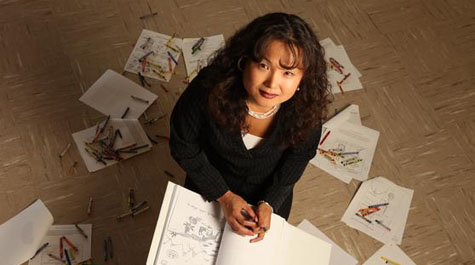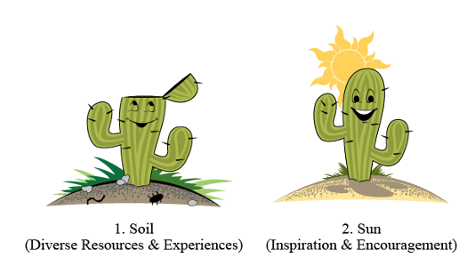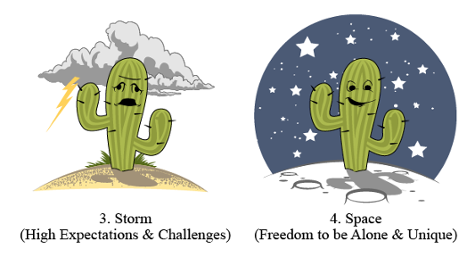The cure for the creativity crisis
The theory of relativity, the discovery of radioactivity, the rise of American Modernist art, the Apple iPhone — each of these innovations are largely considered to be some of the greatest breakthroughs made by geniuses in their respective fields. But, according to William & Mary Professor of Education KH Kim, it doesn’t take a rocket scientist, an art prodigy or a tech wizard to dream up game-changing concepts like these. Anyone can become the next Einstein, Curie, O’Keeffe or Jobs.
“If you look at the early childhoods of these people, you will realize that they were not born geniuses,” said Kim. “Based on my research, genetics does not affect a lot; it’s more about the attitudes you develop, which can change with your environment and with practice. I believe that most people who are exposed to the same things as Albert Einstein was when he was growing up will become innovators like he did.”
Kim has spent the last 25 years researching creativity in the United States. In 2010, she coined the phrase the “Creativity Crisis,” referring to the steady decline in scores on Torrance Tests of Creative Thinking (equivalent to an IQ test in creativity) since 1990. Her latest book, The Creativity Challenge: How We Can Recapture American Innovation, provides a recipe for reversing the crisis and developing creative potential in individuals through climates and attitudes that foster innovative thinking.
“I wanted to make a book that’s really practical, so that anyone can use the information to find and develop their own creativity,” said Kim.
{{youtube:medium:left|kBm7haoVMIw, KH Kim discusses creativity.}}
The Crisis
Kim’s discovery of the “Creativity Crisis” resulted in an immediate wave of interest, including a Newsweek cover story, and a slew of curious reporters asking the obvious question: “Why?”
While Kim has theories as to what caused the gradual shift away from creativity — including excessive testing culture and domestic insecurity, or a desire for financial security and maintaining the status quo, rather than continuing to evolve — it’s the implications of the crisis that are more concrete.
Indicators of a state of lessened creativity, Kim said, include a decline in U.S. patents since 1996, a reduction in public and private research and development funds (compared to a significant increase in Asian countries) and the decline in college and university research articles published in peer-reviewed journals.
“My research shows that America has an increasingly limited number of individuals who are capable of finding and implementing solutions to problems the nation faces today,” Kim said in her book. “If the trend isn’t reversed soon, America will be unable to tackle the challenges of the future.”
The Solution: Creative Climates
Using metaphors related to gardening and anecdotes from the early lives of famous innovators such as Steve Jobs and Nelson Mandela, Kim’s book outlines the three steps needed for innovation: cultivate creative climates, nurture creative attitudes, and develop creative thinking skills. These four creative climates (soil, sun, storm and space) and 27 attitudes — or the ways in which individuals react to the climates — must be introduced and encouraged in order for creativity to flourish.
“I call them attitudes rather than personality traits because 50 percent of your personality is genetic, so it’s hard to change,” said Kim. “But you can change attitudes through practice. Anyone can develop the attitudes of innovators.”
In the soil climate, individuals must first be exposed to diverse resources and experiences in order for creative attitudes, such as open-mindedness and resourcefulness, to develop. Kim explains how Albert Einstein’s parents, who themselves came from very different, non-conformist backgrounds and exposed Albert to a variety of topics from music and literature to math, encouraged his inquisitive and daydreaming nature that incited disdain from teachers, who believed he wouldn’t amount to anything.
Einstein succeeded, however, in part because of his sun climate, or the inspiration and encouragement he received from his parents and several mentors throughout his life, including an uncle who playfully taught him math and a young medical student who fueled his curiosity in scientific concepts.
Following the soil and sun climates, which enable innovators like Einstein to explore interests and hone in on a single passion, the storm climate introduces challenges along the creative path. The final climate, space, gives innovators the freedom to dream — an invaluable step in generating unique solutions, ideas and inventions based on their expertise.
“A lot of people think that creativity is generating a new idea out of the blue,” said Kim. “But it’s not. Before you generate this unique idea, you have to develop your expertise in one specific subject first so that you can have a lot of material in your brain, and then you can mix your expertise and ideas to create something new.”
The Solution: Creative Attitudes
Within each creative climate, innovators often exhibit a certain set of attitudes that lead to creative thinking. But many of these attitudes, Kim said, can often be discouraged because of their potentially negative interpretations.
“Many innovators in history who have changed the world were troublemakers or misfits as children, because they exhibited creative attitudes that can be both positive and negative, but they later became successful because they found people who saw the positive sides of these attitudes and worked with them” said Kim.
Open-mindedness, for instance, which Kim said is one of the most consistent attitudes found among innovators, embraces distractibility and avoids systematic focus — seemingly negative side effects — to allow distant, potentially innovative thoughts to enter the mind.
Yet, open-mindedness, along with bicultural, mentored and resourceful attitudes, are some of the most important traits in the soil climate for identifying a topic a person is curious or interested in. These can often be achieved by seeking out exposure to different places, opinions, cultures and teachers. Once an interest is identified, exploring the subject with optimism, curiosity, spontaneity and playfulness (described as seeing the lighter side of challenges) can help sustain energy to explore the subject in depth.
As the storm climate brings challenges and hard work to a creative pursuit, attitudes like independence, resilience, self-discipline and diligence will help an innovator gain the expertise necessary to understand how things can change. Learning organizational and time management skills, avoiding distractions, setting clear goals and viewing failures as lessons are common practices among innovators with these attitudes.
“At least 10 years – according to the 10-year rule – of diligent work and deep immersion is necessary for developing expertise in an innovator’s chosen field,” said Kim.
In the space climate, where creativity culminates in innovation, non-conforming and defiant attitudes enable innovators to think outside the box, rejecting existing norms and traditions. On the other hand, they must remain compassionate in order to bond with mentors and remain attuned to what people (the audience or customers who will benefit from their innovation) want and need.
“My book emphasizes that no innovator worked alone,” she said. “It does not mean that you have to collaborate. But you do have to find someone who can highlight your strengths and compensate for your weaknesses so you don't have to waste time overcoming or working on your weaknesses.”
Self-reflection, an attitude often associated with introverts, is also imperative in the creative process, as it avoids negative social influences and gives the innovator time to think objectively without distraction. Many innovators, Kim said, enjoyed gardening, because it gave them time to be alone with their thoughts in nature.
Teaching creativity
While Kim often addresses parents and teachers of future innovators in her book, she said that the tips and steps provided can help unlock the creative potential in children and adults alike. Even those who have already identified their strengths and chosen their careers can develop the attitudes and practice the creative thinking skills to become an innovator in their field.
“So many people think that innovators are born,” she said. “But based on my 25 years of research, I am confident to say that all people can be creative if they are in the right climates and develop the right attitudes, while developing expertise on their subject of curiosity, preference, or interest for 10 years.”


















